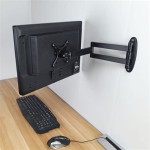Understanding the Wall Mount Garage Door Opener Button
The wall mount garage door opener button, a seemingly simple component, plays a critical role in the functionality and safety of a garage door system. This device provides a convenient and reliable method for activating the garage door opener, allowing users to easily enter and exit their garage. While often overlooked, understanding its operation, wiring, and potential issues can be crucial for maintaining a smoothly functioning and secure garage.
The primary function of the wall mount button is to send a signal to the garage door opener motor, initiating either the opening or closing sequence. This is achieved through a low-voltage electrical circuit that connects the button to the opener unit. When the button is pressed, the circuit is closed, sending a signal that triggers the motor to operate.
Beyond its basic function, modern wall mount buttons often incorporate additional features designed to enhance convenience and security. These features may include a light control button, which allows users to turn the garage door opener light on or off independently of the door operation. Some models also include a lock function that disables the remote controls for added security, preventing unauthorized access.
Key Point 1: The Basic Wiring and Functionality
The wiring of a garage door opener button is relatively straightforward, typically involving two wires that connect to specific terminals on the garage door opener motor unit. The terminals are usually labeled for easy identification. These wires carry a low-voltage signal (typically 24 volts DC) from the power supply within the garage door opener to the wall button and back. The circuit is completed when the button is pressed, sending the signal to activate the opener.
The button itself is a simple momentary switch. When pressed, it allows the electrical current to flow, completing the circuit. Releasing the button breaks the circuit. This momentary contact is sufficient to initiate the opener's programmed sequence (opening or closing). The garage door opener motor unit then manages the entire operation, including stopping the door at the appropriate open or closed position.
Understanding the wiring is important for troubleshooting malfunctions. If the button fails to operate the door, a common cause is a loose or disconnected wire. Before undertaking any troubleshooting, it is imperative to disconnect the power to the garage door opener to prevent electrical shock. Once the power is off, the connections at both the button and the opener unit should be inspected. If the wiring appears damaged or frayed, it should be replaced with appropriate low-voltage wire.
In some instances, the problem may not be with the wiring but with the button itself. The internal switch mechanism can degrade over time, especially if the button is frequently used. A simple test to determine if the button is faulty involves using a multimeter to check for continuity when the button is pressed. If there is no continuity, the button needs to be replaced.
Newer, more sophisticated garage door openers might use a digital communication system instead of a simple two-wire circuit. These systems typically use a data signal to communicate between the wall button and the opener unit. While the basic principle of operation remains the same – the button initiates the door's movement – the underlying technology is more complex. Troubleshooting these systems often requires specialized knowledge and equipment.
Key Point 2: Common Problems and Troubleshooting
Several issues can prevent the wall mount garage door opener button from functioning correctly. One of the most frequent problems is a simple disconnection of the wiring. This can occur due to vibration, physical damage, or accidental dislodgement. Regularly inspecting the wiring connections at both the button and the opener unit can help prevent this issue. Ensuring the wires are securely fastened to the terminals is crucial.
Another common problem is a dead or weak battery in the garage door opener remote controls. While this doesn't directly affect the wall button, it can lead users to incorrectly assume the wall button is faulty. Checking the batteries in the remotes is always a good first step in troubleshooting garage door opener problems.
A more complex issue can arise from a problem within the garage door opener motor unit itself. If the receiver that interprets the signal from the wall button is malfunctioning, the button will not operate the door. In this case, the troubleshooting process is more involved and may require professional assistance. The receiver might need to be reset or replaced. Another potential problem within the motor unit is a faulty logic board. This board controls the operation of the motor and other related functions. If the logic board is damaged, it can prevent the wall button from working.
Beyond wiring and internal components, environmental factors can also contribute to malfunctions. Extreme temperatures or humidity can affect the performance of the button or the opener unit. Water damage is a significant concern, as it can corrode wiring and damage electronic components. Taking steps to protect the garage door opener system from the elements is essential for maintaining its reliability.
Sometimes, the issue isn't with the button or the opener, but with the garage door itself. If the door is obstructed or experiencing mechanical problems (such as broken springs or damaged tracks), the opener may not operate, regardless of whether the wall button is functioning correctly. Regularly inspecting and maintaining the garage door is crucial for ensuring the entire system operates smoothly.
Key Point 3: Advanced Features and Security Considerations
Modern wall mount garage door opener buttons often incorporate additional features beyond the basic open/close functionality. One common feature is a light control button, which allows users to turn the garage door opener light on or off without operating the door. This can be convenient for illuminating the garage interior without opening the door, enhancing safety and security.
Another increasingly common feature is a lock button, also known as a vacation mode. This feature electronically disables the remote controls, preventing unauthorized access to the garage. When activated, the remote controls will not be able to open the door, providing an added layer of security, especially when the homeowner is away for extended periods. The wall button typically remains functional in this mode, allowing residents to open the door from inside the garage.
Some advanced wall mount buttons also incorporate diagnostic features that can help users troubleshoot problems. These features may include indicator lights that display error codes or provide information about the status of the opener. Consulting the garage door opener's manual is crucial for understanding these features and interpreting the error codes.
Security considerations are paramount when it comes to garage door openers. Older models used fixed codes, which were susceptible to being intercepted and duplicated. Modern openers utilize rolling code technology, which generates a new code each time the door is operated. This significantly reduces the risk of unauthorized access. Ensuring the garage door opener uses rolling code technology is a vital security measure.
Beyond the technology of the opener itself, physical security measures are also important. Regularly inspecting the garage door and its components for signs of damage or tampering is essential. Ensuring the emergency release handle is accessible but not easily reachable from outside the garage can help prevent unauthorized entry. Reinforcing the garage door itself can also deter potential intruders.
The location of the wall mount button can also impact security. Ideally, the button should be mounted in a location that is not easily visible from outside the garage, preventing potential intruders from attempting to manipulate it through a window. Mounting the button at a reasonable height, accessible to all household members, is also important.
Finally, it's crucial to be aware of the potential for hacking or wireless interference. While rare, these vulnerabilities exist. Regularly updating the garage door opener's firmware (if applicable) and being mindful of potential sources of interference can help mitigate these risks.
Understanding the functionality, potential issues, and security considerations related to the wall mount garage door opener button is essential for maintaining a safe, secure, and smoothly operating garage door system. Regular inspection, maintenance, and awareness of advanced features can help prevent problems and ensure the system functions reliably for years to come.

Chamberlain Universal Garage Door Opener Wall Controls In The Parts Accessories Department At Com

Chamberlain 41a7327 1 Motion Detecting Wall Control Console Security 2 0 Ttc

Er S Guide Wall Consoles Push Buttons For Genie Openers The

041a7305 1 Wall Control Panel Parts Liftmaster

Liftmaster 75lm Wall Mounted Illuminated Wired Doorbell And Garage Door Opener Push Button

Two Button Wireless Wall E138m Merlin Au

Pbs 3 Garage Door Opener Push Button Wall Mount Control Station

Chamberlain Garage Door Wired Wall Control Button

Garage Door Opener Wall Mounted Button 41a5273 Multi Function Control Panel 78lm

2 Pack Garage Door Opener Switch Push Doorbell Button Wired Lighted Wall Mounted Blue Light








